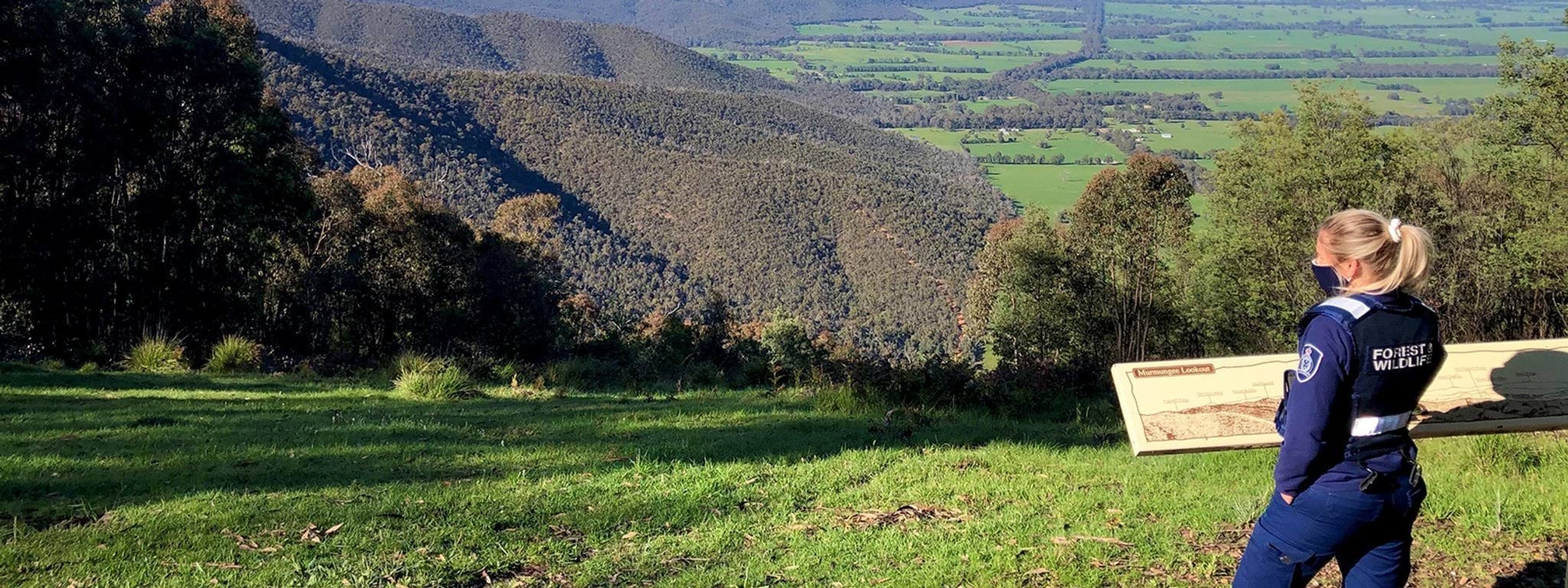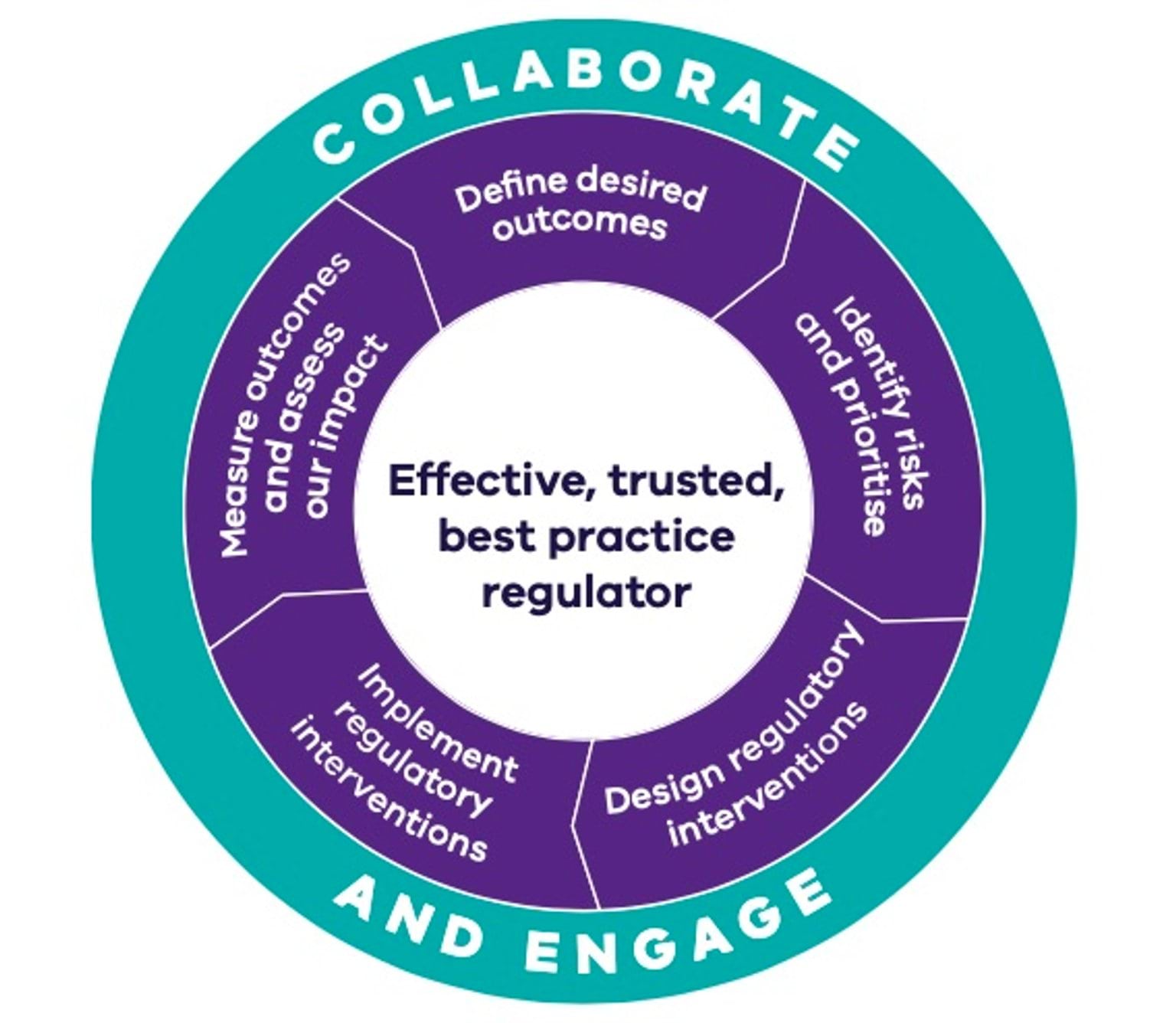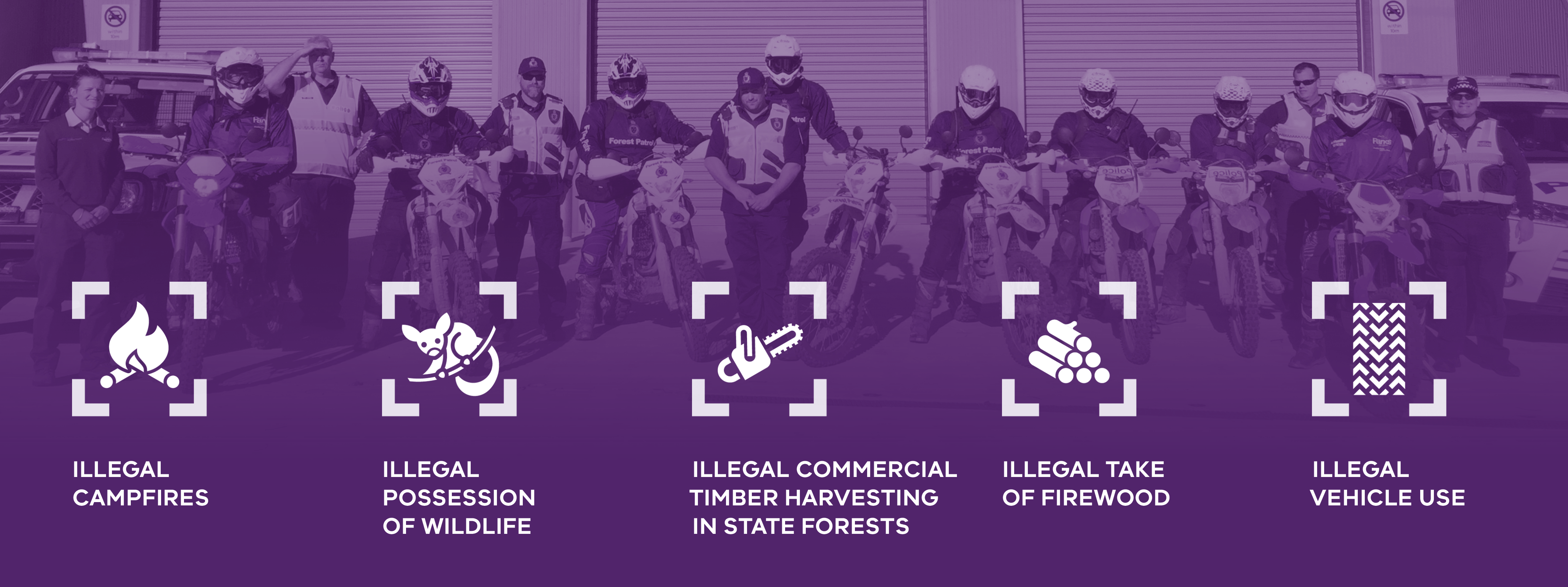- Published by:
- Department of Energy, Environment and Climate Action
- Date:
- 1 Oct 2021
The Regulatory Priorities 2021 – 2022 support the Conservation Regulator to focus regulatory efforts on activities that ensure Victorians have safe and equitable access to our forests, parks and natural environment while at the same time protecting our wildlife and ecosystems.
Foreword
The Regulatory Priorities 2021 – 2022 support the Conservation Regulator to focus regulatory efforts on activities that ensure Victorians have safe and equitable access to our forests, parks and natural environment while at the same time protecting our wildlife and ecosystems.
The coronavirus (COVID-19) pandemic has impacted the way we live, work, and enjoy the natural environment. It has been fantastic to see so many Victorians out enjoying our natural environment during times of eased restrictions with unprecedented visitation across the forest estate. It has also been interesting to see how COVID has affected trends in wildlife licenses with an increase in applications to keep native wildlife as pets coinciding with COVID restrictions.
The Conservation Regulator has risen to the challenge of delivering our Regulatory Priorities and core activities with these changing trends.
We have continued to work to protect our natural environment while we also provide support to the Victorian Government’s response to the coronavirus pandemic.
Our annual review of the risk of harm to our biodiversity and natural heritage values has shown that climate change and population growth continue to be driving factors, influencing our risks into the medium and longer-term. For us, as a regulator, this means increased pressure on, and competing demands for, the environmental and social values we are trying to protect. It further heightens the need for effective prioritisation of our resources, and for us to understand and plan for natural disasters, climate change impacts on ecosystems and demand for access to public land across the landscape.
This year’s priorities reflect a range of factors that will influence compliance and harm to the environment over the next year.
This includes visitation numbers to public land during peak times since the onset of the coronavirus pandemic, increases in the sales of off-road vehicles, higher demand for wildlife as pets, and changes in energy demands leading to increased take of firewood while people spend more time at home.
We have refined our priorities to direct our effort to where it will have the most impact and we will continue to use a range of regulatory tools to address non-compliance in these priority areas in collaboration with key regulatory partners and the community.
I look forward to continuing our important work to conserve and protect our environment for future generations.
Kate Gavens, Chief Conservation Regulator
The Conservation Regulator
The Conservation Regulator was established by the Department of Environment, Land, Water and Planning to be accountable for timber harvesting, biodiversity, fire prevention and land‑use regulation.
Vision
Our vision is to create and maintain liveable, inclusive, sustainable communities and thriving natural environments.
Regulatory mission
Our regulatory mission is to be an effective, trusted, best practice regulator.
Regulatory outcomes
DELWP regulates to achieve three outcomes:
- Equitable and safe access to public land and use of natural resources.
- Protected natural and heritage values.
- Sustainable communities – social, economic and environmental.
How we work
The Conservation Regulator is committed to working collaboratively and transparently with the community and stakeholders to improve conservation regulation in Victoria.
The Conservation Regulator’s regulatory functions include:
- setting priorities for regulatory activities
- informing and educating about the law
- providing clear standards and guidance
- monitoring compliance and enforcing the law.
The changing environment
Victoria’s natural environment is a dynamic system, constantly undergoing and responding to change in the short and longer-term. The driving factors for environmental decline within Victoria continue to be population growth, and the corresponding increase in human activities, and climate change.
These will continue to be the main drivers of change for the foreseeable future and pose the biggest threat to the long-term health of our environment.
During 2020-21 there were two significant events that impacted population growth and the climate in Victoria.
- The coronavirus pandemic led to a reduction – and even reversal – of population growth in some parts of Victoria.
- A La Niña weather pattern, which brings cooler and wetter weather to eastern and southern Australia, temporarily breaking the trend towards increased dryness.
These two events have had a significant impact on our work during the last year, however, they do not change the longer-term trends and impacts we are seeing from population growth and climate change.
Population growth
Population estimates suggest Victoria could have 400,000 fewer residents than originally forecast for the end of 2022.
During the pandemic, Melbourne experienced a 30% decrease in the number of people moving to the city and data shows a net number of 7,500 left Melbourne with 3 in 5 of those moving to the regions.
Australia’s population growth in 2020 was the lowest it has been since 1916, during the first world war, when the population decreased, according to Australian Bureau of Statistic figures. The national population growth was 0.5%, while Victoria had the lowest growth nationally at 0.01%. This is largely driven by net overseas migration, which became negative from March 2020 in alignment with the closure of Australian borders and the declaration of a pandemic by the World Health Organisation on 11 March 2020.
Despite the changes, these numbers are not expected to significantly impact the use of public land around population centres, in the short or long term. A reduction in population growth does not alleviate the existing pressures on our ecosystems from human activity. It is a temporary reduction in the rate of increase.
Reduced travel options during the pandemic, a trend towards outdoor activities for health reasons, constrained budgets and changing preferences for recreational activities will continue to drive high visitation numbers on public land over the coming year.
While numbers and timelines remain uncertain due to the unique circumstances of the coronavirus pandemic, the scale of the public health response, economic impacts, and population growth will continue to be a long-term trend in Victoria - especially once international travel becomes less restricted and the local and global economies recover.
Climate change
The Victorian environment continues to be affected by climate change. In 2020, Australia had its fourth warmest year since records began, despite the seasonal weather being driven by a La Niña phase of the El Niño–Southern Oscillation (ENSO), which usually brings colder and wetter weather.
The more frequently occurring ENSO phase, El Niño, is associated with hotter and drier weather in Australia and Victoria. However, due to climate change, we are now seeing La Niña years that are warmer than historically recorded El Niño years.
The Bureau of Meteorology manages an ENSO watch to forecast whether we are likely to see an El Niño, La Niña or neutral driver of our weather in the coming year. Their data shows that these events typically occur irregularly between 2 to 7 years apart, however, climate change is likely to increase the severity and frequency of these weather patterns, subjecting Victoria to more frequent instances of extreme weather.
This means more frequent El Niño and the associated drought and heatwave conditions. These conditions lead to more frequent and extreme bushfire events. Extreme bushfires can burn our forests more completely and extensively than ordinarily, leaving them even more susceptible to loss of soil, flooding, landslide, and polluted waterways following significant rain events. Increased flooding also threatens our wildlife, which can be susceptible to drowning.
It is currently unknown when drought conditions or the hotter drier El Niño weather pattern will add to climate change pressure with higher temperatures, below-average rainfall and increased bushfire risk in Victoria.
Climate change will continue to drive extreme weather events that damage our environment, wildlife and way of life, including:
- Heatwaves
- Extreme fire weather
- Bushfire smoke
- Damaging storms and more severe thunderstorms
- Heavy rain
Establishing the context for 2021 – 2022
In addition to climate change and population growth, a number of other important factors were identified as influencing our regulatory priorities.
Coronavirus pandemic
The coronavirus pandemic has changed the way in which we live, work and spend our leisure time. Outside of public health restrictions, we saw higher than usual visitation numbers to Victorian public land during 2020-21. This trend is expected to continue during 2021 – 2022 due to travel restrictions with people more likely to continue to holiday closer to home in the outdoors.
Peak weekly visitation to public land for recreation in some locations increased by more than ten times recorded visitation before the onset of the coronavirus pandemic. This has been particularly prevalent in public land closer to urban areas. For example, Lake Burrumbeet, near Ballarat, had a peak weekly visitation of over 3,400 to its southern shore in January 2019 while in 2021 that more than doubled to over 7,600.
Off-road vehicle use
Changes in personal tastes and recreation have seen a move away from traditional team-based activities to more individualised activities. This is in part responsible for an increase in the purchase, and subsequent use on public land, of off-road vehicles. These include trail bikes and other all-terrain vehicles.
These increases are likely to continue in 2021 – 2022 as the economy recovers and while people are still holidaying closer to home in the outdoors.
Bushfire recovery
Recovery from the significant 2019-20 bushfires will take many years as forests regrow and burnt land continues to be more vulnerable to extreme weather events.
Native wildlife will continue to be at risk during the slow regeneration of lost forest and are more vulnerable to future bushfires.
Significant scientific uncertainty will remain for some time while knowledge develops on the extent of the impacts of the 2019-20 bushfires and how species are recovering.
Native timber harvesting
Environmental laws relating to timber harvesting allow natural values to be protected while providing sustainable access to timber resources.
A natural value in a forest may be a particular threatened species, a cultural heritage site, a source of clean water or something less specific like biodiversity.
The implications of the 2019-20 fires on forest biodiversity have contributed to the focus of the Conservation Regulator on ensuring forest values are adequately protected.
Plantation timber
Timber plantations comprised of native species, such as blue gums, are also leading to an increase in human-wildlife interaction and the potential for conflict as wildlife move into these environments.
When it comes time to harvest, this can put wildlife, such as koalas, at risk of harm and the management of this risk will be important for the Conservation Regulator in 2021 – 2022 and beyond.
Wildlife
The coronavirus pandemic, despite restricted pathways for the import and export of wildlife due to international travel restrictions, saw a global boom in online wildlife trade. We know that the pandemic has driven an increase in the demand for exotic pets globally with Australian wildlife sometimes fetching high prices.
Demand for keeping wildlife as pets has been increasing in recent years. Applications for new private wildlife licences has grown over 24% in 2019-2020 and another 21% in 2020-2021.
Demand for firewood
Firewood supply continues to be constrained and this is expected to continue in the future. The depletion of firewood stocks during major bushfires and additional home heating costs arising from the coronavirus pandemic is expected to have increased firewood demand.
The illegal take of firewood continues to be an issue damaging wildlife habitats and culturally significant sites.
Our regulatory approach
DELWP’s Regulatory Framework describes how we deliver our regulatory functions in collaboration with the community and co-regulators. Statements of regulatory intent provide a detailed explanation of how the Conservation Regulator uses its powers to prevent and respond to breaches of the law in specific areas.
The regulatory framework
DELWP’s Regulatory Framework describes how we deliver our regulatory functions in collaboration with the community and co-regulators.
Collaborate and engage
We develop and maintain productive and effective relationships with communities, Traditional Owners, co-regulators, regulated parties and peak bodies.
Conduct risk-based and intelligence-led regulation
Good intelligence requires strong relationships and networks to identify emerging risks.
Address priority risks
By being clear about what we are trying to achieve, applying a consistent risk approach, and designing, implementing and reviewing the effectiveness of our regulatory interventions.
The Conservation Regulator’s Regulatory Priorities 2021 – 2022 draws on the principles in the Regulatory Framework to define the risks and regulatory priorities for this year.
Compliance and enforcement policy
The Compliance and Enforcement Policy sets out:
- how we encourage voluntary compliance with the law
- the range of compliance and enforcement tools available, depending on the culpability and harm to the environment
- how we will apply the law and exercise judgement in carrying out our compliance and enforcement activities.
Our Regulatory Priorities reflects a balance between encouraging voluntary compliance (setting standards, informing and educating, supporting compliance) with effective regulatory risk management (issuing permits, licenses and authorisations, monitoring compliance, enforcing the law).
Statements of regulatory intent
Statements of regulatory intent provide a detailed explanation of how the Conservation Regulator uses its powers to prevent and respond to breaches of the law in specific areas.
Regulating the Protection of Wildlife
The Statement of Regulatory Intent for the Protection of Wildlife was published for public consultation in July 2021 and will be finalised in light of feedback in 2021.
The statement sets out proposed commitments for how the Conservation Regulator will acquit its responsibilities for wildlife regulation and measure its performance as a regulator in protecting wildlife, including the sustainable use of and access to wildlife.
Regulating timber harvesting in State forests under the Allocation Order
This Statement of regulatory intent outlines the role of the Conservation Regulator in regulating timber harvesting in State forests under the Allocation Order and describes what the community and industry can expect from us as a regulator.
Specifically, it describes how the Conservation Regulator intends to use the regulatory tools that are available to it under the law.
The Year in Review
The Conservation Regulator published its first Year in Review 2019-2020 which outlines the progress we made in our first full year of operation from 1 July 2019 to 30 June 2020.
The Year in Review will be published annually and describes the progress towards our regulatory priorities and our key achievements.
State-wide priority regulatory risks
This plan outlines our approach for managing priority regulatory risks during 2021 – 2022. The plan sets out our state-wide regulatory priorities. We will enforce compliance across all our regulatory responsibilities but will prioritise our effort for these state-wide priorities.
Regulatory risks
Regulatory risks usually evolve over time but can change quickly when there is a change in the environment or new information comes to light that allows us to see a risk in a new way.
Regulatory risks are events or activities that could harm our:
- natural and heritage values
- equitable and safe access to public land and use of natural resources
- sustainable communities – social, economic and environmental.
Establishing context
A wide range of information and sources are considered when we establish the context for our risk assessment to determine our regulatory priorities. This includes:
- identifying new and emerging trends
- conducting research
- consultation with stakeholders
- the experience and knowledge of our staff
- working with our regulatory partners.
Assessing risk
Regulatory risks are identified as events or activities that could prevent DELWP from achieving its outcomes.
Assessing risk:
- reduces the impact of major bushfires and other emergencies on people, property and the environment
- promotes a healthy, resilient and biodiverse environment
- enables productive and effective land management
Risk prioritisation is based on the likelihood of the risk event occurring and the consequences or impacts if the risk occurs. A wide range of information is considered in the context of the frequency, timing and potential harm of the events or activities.
The Conservation Regulator assesses a matrix of risk statements, with those that receive the highest ratings translated into our regulatory priorities.
At the strategic level, we review 18 categories of risks across 6 themes that include:
- biodiversity (which covers a wide range of matters relating to protected flora and wildlife)
- bushfire prevention
- recreational and social use of public land
- dumping of waste on public land
- commercial use of public land
- timber harvesting.
Top risks for 2021 – 2022
The regulatory priorities are the result of a detailed risk analysis. The risks identified for 2021 – 2022 reaffirm previous trends and include:
- unauthorised firewood collection in commercial quantities, including personal use where it negatively impacts the environment
- the illegal possession and trade of wildlife, leading to the undue suffering of wildlife or loss of individuals, populations or species
- campfires on total fire ban days, or that are unattended or poorly constructed
- illegal vehicle use on public land, leading to habitat fragmentation and infrastructure destruction, and the loss of equitable and safe access to public land
- regulating native timber harvesting, where there is a loss of habitat, ecosystem function, or impact on wildlife.
In response to these risks, and within the scope of the Conservation Regulator’s responsibilities, we will focus on the following regulatory priorities:
- illegal campfires
- illegal possession of wildlife
- illegal commercial timber harvesting in State forests
- illegal take of firewood
- illegal vehicle use.
Illegal campfires
The risk of bushfires in Victoria is predominantly a threat from November until March each year, and while 2020-21 was wetter than usual, the long-term trend is for hotter and dryer conditions leading to more intense bushfire seasons, such as the devastating 2019-20 season.
Currently, we are seeing more people spend time on public land due to travel restrictions, and the desire to escape crowded, urban areas. In some places, we have seen weekly visitor numbers peak at more than double what they were for the same time of year prior to the onset of the coronavirus pandemic. This is a significant increase in the likelihood of people starting campfires that are unsafe and illegal.
The increase in the frequency of campfires increases the likelihood that there will be more frequent incidences of non-compliance that are more likely to lead to bushfires.
The Conservation Regulator will continue to prioritise the safety of communities and the protection of the environment from the devastating impact of bushfires by reducing risks from unauthorised and poorly managed campfires. The Conservation Regulator’s authorised officers patrol public land in partnership with Forest Fire Management Victoria to detect illegal campfires, inform and educate the public, and issue infringements in accordance with our Compliance and Enforcement Policy.
Illegal possession of wildlife
Wildlife is an essential part of our environment and essential to the functioning and health of our ecosystems. The Conservation Regulator has an important role in regulating the use, treatment, trade and control of wildlife.
The loss of key wildlife species can lead to the collapse of ecosystems, which we rely on for clean air, water, the production of food, and a range of economic activity, including eco-tourism and agricultural systems.
The conservation and sustainability of wildlife are under increasing pressure from threats such as loss and fragmentation of habitat, introduced pests such as foxes and cats, illegal take from the wild, wildlife trafficking, climate change and growing human populations over the longer-term coinciding with shrinking native habitats.
Illegal trafficking and possession pose a significant threat to our native species, which can fetch very high prices in foreign markets and domestically.
The harms include:
- Suffering of individual animals due to the methods used to transport animals across borders are often cruel and causes suffering and death to individual animals.
- Permanent damage to habitat, such as people removing hollows or stones while searching for wildlife to take.
- Damage to ecosystems, with the removal of animals making it difficult for wildlife already under pressure from a changing environment to recover.
- Illegally kept animals may not be appropriately cared for, and the close interaction with wildlife can facilitate the spread of disease.
- Animals illegally released may also become invasive pests if it occurs in an area where they are not otherwise endemic or they may introduce foreign pathogens to populations with no natural immunities.
The Conservation Regulator will respond swiftly and intently to all serious and significant incidents of wildlife crime.
Illegal commercial timber harvesting in State forests
VicForests is the State-owned business responsible for the harvest, commercial sale and re-growing of timber from Victoria’s State forests on behalf of the Government. Timber harvesting in State forests is permitted by law, but this must be done in a way that is compliant with the law.
The Conservation Regulator regulates commercial timber harvesting in State forests in accordance with the Code of Practice for Timber Production 2014 (the Code) and the Management Standards and Procedures for Timber Harvesting Operations in Victoria’s State Forests 2014 to ensure forest values are protected for current and future generations.
Unauthorised timber harvesting can cause serious harm to flora and fauna.
The 2019-20 bushfires significantly impacted a number of species and communities in forest-dependent environments. In May 2021 DELWP released a Threatened Species and Communities Risk Assessment (TSCRA) to ensure interim protections to reduce the risk of timber harvesting operations causing serious or irreversible harm to the environment in a post-fire landscape.
The Conservation Regulator will continue to monitor and enforce timber harvesting legal obligations focusing on areas of highest environmental risk.
Illegal take of firewood
The illegal take of firewood for personal use or in commercial quantities leads to the destruction of wildlife habitat.
Preventing the destruction of habitat is critically important at a time wildlife populations and ecosystems are still recovering from bushfires while climate change is leading to hotter and drier conditions.
The Conservation Regulator has undertaken an in-depth analysis of the illegal take of firewood in Victoria, which we are using to inform our strategy over the coming year and beyond.
This work will include improving how we work with other regulatory agencies, operational improvements, and the development of better sources of intelligence.
Reports of illegal firewood collection have increased by up to 200% in 2021. This increase in reports is the result of multiple factors, including improved detection and reporting, and increased demand.
Illegal vehicle use
The legal use of vehicles on Victoria’s public land contributes to our health and wellbeing by providing opportunities for recreation and supporting social cohesion. Nearly 40% of Victoria is public land, including State forests, which are great places to use vehicles like 4WDs, trail bikes and mountain bikes in approved areas.
However, the use of these vehicles has the potential to cause serious damage to the environment, cultural sites, and restrict the fair and equitable use of public land. Consequently, the use of vehicles on public land is a regulated activity.
Illegal vehicle use on public land usually involves driving off-road on walking tracks, through the bush or areas closed to the public and poses serious risks and issues, which include:
- Damage and destruction to the environment, ecosystems and harm to wildlife; cultural sites; public assets and infrastructure such as gates, roads, fences and signage
- Spread of soil-borne pathogens
- The high financial costs for the remediation of public assets and infrastructure
- The safety of those engaging in illegal behaviour, such as the increased risk of injury
- The safety and disturbance of other users of public lands, such as those camping or hiking
- Hindering emergency services due to damage and destruction to roads
Population growth in the longer term, the lower cost of recreational vehicles and a cultural shift away from organised sport towards casual, informal forms of recreation have driven an increase in off-road activities on public land.
The Conservation Regulator will continue to partner with co-regulators and reduce the risk to our environment and ensure fair and equitable use of our public land.
State-wide regulatory priorities
In response to the risks of illegal campfires, illegal possession of wildlife, illegal commercial timber harvesting in state forests, illegal take of firewood and illegal vehicle use, Conservation Regulator has identified why non-compliance can happen, what we aim to achieve, how we will do this, who we work closely with, and its priority.
Illegal campfires
Why non-compliance can happen
- High visitor numbers, especially while travel is restricted
- Lack of awareness of regulations
- Lack of awareness of how to safely manage campfires, and how quickly and easily they can become out of control
- Lighting fires on day of total fire ban
We aim to
- Raise awareness of the regulations, reduce the prevalence and risk of unauthorised campfires
How we do this
- Providing clear information about campfire regulations and campfire safety on DELWP’s website, customer centres, during patrols and through media campaigns
- Supporting the annual Don’t let your campfire become a bushfire campaign, reminding campers across the state to be alert when it comes to campfire safety
- Intelligence analysis of reports of unsafe behaviours and high-risk times and locations
- Conducting surveillance and patrols in high-use, high-risk locations, during fire hazard days, and targeting high-risk behaviours
- Investigating reports of unsafe campfire activities
- Where appropriate, initiate enforcement actions
- Publicise enforcement actions
We work closely with
- Parks Victoria
- Forest Fire Management Victoria
- Country Fire Authority
Priority
- We will enforce compliance at any time but this is a priority between September and April
Illegal possession of wildlife
Why non-compliance can happen
- Lack of awareness of regulations
- Economic gain through illegal trade
- Lack of awareness of the harm non-compliance can do to wildlife habitats
- Disregard for the welfare of animals
We aim to
- Raise awareness of the regulations and improve the protection, conservation and interaction with Victoria’s wildlife
How we do this
- Publish a Statement of Regulatory Intent on Wildlife
- Publish information on how to apply for a licence, permit or authorisation on our website
- Deliver information and guidance to support a common understanding of how to comply with the law
- Support licence and permit holders in understanding their obligations to prevent non‑compliance
- Administering permissions under the Wildlife Act 1975
- Reforming wildlife permissions, initially focusing on Authorities to Control Wildlife
- Use community information and other intelligence to target our compliance and monitoring activities
- Monitor compliance with licence and permit conditions
- Investigate and respond to wildlife crime, prioritising serious and significant incidents
- Publish information about our major operations through a variety of channels, such as our website and Twitter
- Publicise enforcement actions
We work closely with
- The Department of Jobs, Precincts and Regions
- Game Management Authority
- Parks Victoria
- Victoria Police
- Agriculture Victoria
Priority
- This is an ongoing priority through 2021 – 2022
Illegal commercial timber harvesting in State forests
Why non-compliance can happen
- Pressures to maximise production volumes to meet customer needs and minimise costs of harvesting
- Inconsistent application and interpretation of the law, including the application of the precautionary principle within the Code of Practice for Timber Production 2014
We aim to
- Ensure that timber allocated to VicForests for harvesting in State forests is managed in line with the law and code of practice, to protect forests for current and future generations
How we do this
- Providing information to VicForests to comply with its obligations under the law through clear statements of regulatory expectation and guidance
- Ensuring that the standards and guidance for complying with the law are clear and well communicated to VicForests
- Delivering education campaigns and engagement events to achieve a common understanding of the regulatory framework
- Conducting surveys and assessments under the Forest Protection Survey Program
- Conducting forest and compliance audits and inspections
- Investigating reports of non-compliance and threatened species
- Initiating appropriate enforcement action for non-compliance
- Publicise enforcement actions
We work closely with
- Department of Jobs, Precincts and Regions
- DELWP Forest Fire and Regions – Policy and Planning Division
- DELWP Biodiversity Division
- Arthur Rylah Institute
Priority
- This is an ongoing priority through 2021 – 2022
Illegal take of firewood
Why non-compliance can happen
- Lack of awareness of regulations
- Economic gain by commercial operators selling to unaware consumers
- Energy prices and cost of wood from legal suppliers
- Diminishing resources due to climate change and overuse
- Perceived low risk of detection and consequences
We aim to
- Raise awareness of the regulations, and the consequences of unauthorised collection
- Increase the likelihood of detection
How we do this
- Implementing the Conservation Regulator’s regulatory strategy for the illegal take of firewood
- Designating firewood collection seasons (Autumn and Spring)
- Signage and pamphlets at designated collection areas
- Restricting zones for access to firewood collection
- Targeting the illegal removal of commercial quantities of firewood
- Providing clear information on the DELWP website about designated areas and regulations
- Intelligence analysis of reports of high-risk areas, behaviours, and times/seasons to inform targeting of surveillance and patrols
- Increasing surveillance of high-risk areas
- Investigating reports of illegal activities
- Where appropriate, initiate enforcement actions
- Publicise enforcement actions
We work closely with
- Parks Victoria
- Forest Fire Management Victoria
Priority
- We will enforce compliance at any time but this is a particular priority between April and October
Illegal vehicle use
Why non-compliance can happen
- Decreasing costs of off‑road vehicles and trail bikes
- The increasing trend towards individual activities
- Lack of awareness of regulations
- Proximity to peri-urban and large regional centres
- Easier access to public land due to clearings made by fires
We aim to
- Raise awareness of the regulations, reduce the prevalence and risks associated with illegal vehicle use on public land
How we do this
- Clear signage and information brochures at point of entry/use
- Providing clear information on the DELWP website and through media about designated areas and regulations
- Restricted zones and seasonal road closures
- Community engagement
- Management and maintenance of vehicle tracks including fencing and barriers to reduce access
- Intelligence analysis and increasing surveillance
- Patrols including in high-risk areas and targeting high-risk behaviours
- Investigating reports of illegal and unsafe activities
- Where appropriate, initiate enforcement actions
- Publicise enforcement actions
We work closely with
- Parks Victoria
- Victoria Police
- DELWP Forest, Fire Operations Division
Priority
- We will enforce compliance at any time but this is a particular priority between April and October
Contact the Conservation Regulator
There are several ways you can communicate with us, whether you’ve seen something that could be a breach in compliance, causing environmental harm, to seek advice, find information or to share your idea.
Visit us online
Head to our website or search Conservation Regulator Victoria.
DELWP Customer Contact Centre
Phone 136 186.
Report suspected wildlife trafficking
Visit the Crime Stoppers Victoria website or phone 1800 333 000.
Timber harvest compliance
Report potential timber harvest compliance issues on our website.
Email us directly
Send an email to conservationregulator@delwp.vic.gov.au
National relay service
If you are deaf or have a hearing impairment or speech impairment, contact us through the National Relay Service by calling 133 677 or visiting the website.
To find out more about what we are doing, follow us on Twitter: @ConservationReg.








